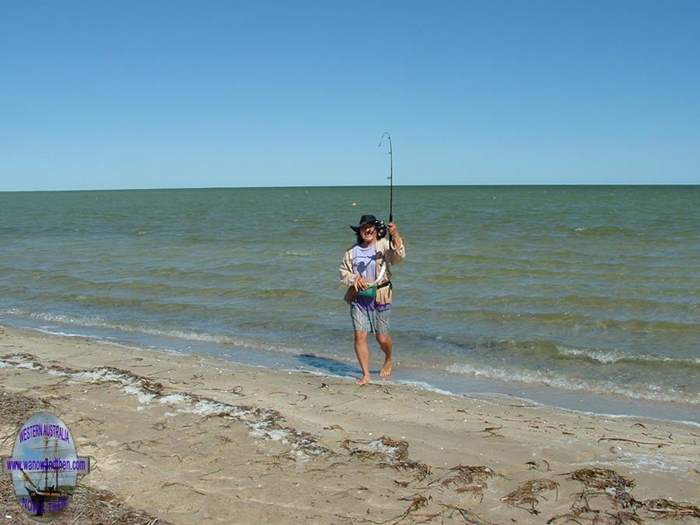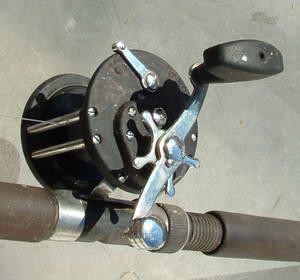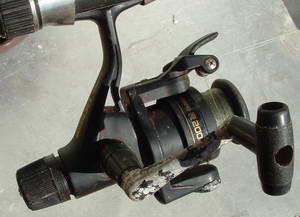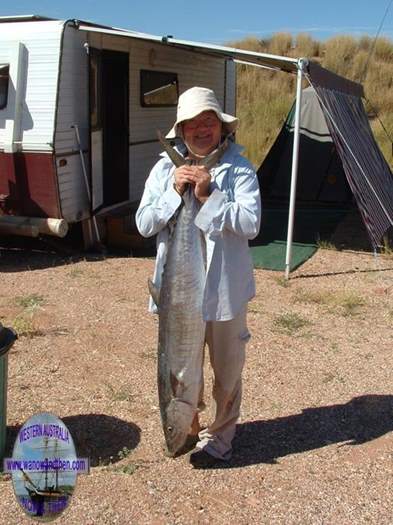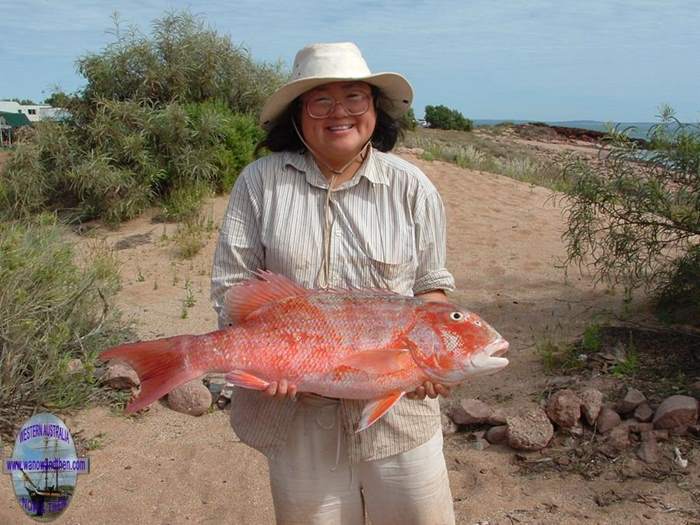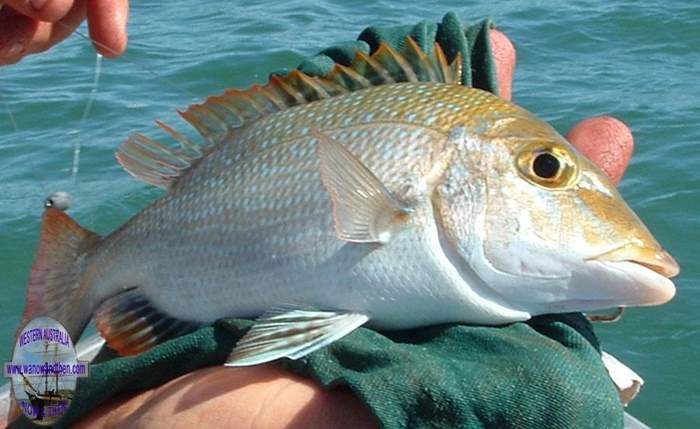|
|
|||
|
|
|
|
|
|
|
|||
FISHING TIPS
|
|
|
|
|
|
WE NEED YOUR SUPPORT. |
|
|
During our travels around Western Australia we like to go fishing whenever we get the opportunity to do so. Our equipment is limited to a small car top dinghy and an assortment of fishing equipment priced at the lower end of the market.
The dinghy is equipped with a 'cheapie' echo sounder and we have a small hand held Garmin 12 channel GPS.
We have all the required safety equipment except a stupidly overpriced EPIRB, so we can get a reasonable distance offshore.
We have a selection of light, medium and heavy rods with reels to match but we try not to spend too much on fishing gear. We still get pretty reasonable results from what we have so it isn't necessary to have the biggest and most expensive gear in order to do well.
Our main target species are whiting, bream, cod, emperor and various types of mackerel. We have had all sorts of incidental catches including tuna, shark, stingray and gurnard.
We have a few favourite tips and tricks that we developed over the years that we are happy to share and so we decided to launch our own fishing page. |
|
|
|
OUR GEAR
We have picked up a range of different fishing gear over the years and much of it has failed to survive. This has been mostly due to a combination of poor quality and lack of proper maintenance. The gear that has survived is hardy and good value.
RODS
Most of the rods we use (except for light whiting rods and beach rods) are solid glass. Solid rods last years longer than hollow rods and although they are heavier they are VERY difficult to break. The biggest problem we have with rods is the fittings being damaged in transit but once you learn to attach replacement parts you can make your rods last a long long time.
|
|
SIDE CAST REELS
Probably the best side cast reels you can get in Australia are made by Alvey. These reels are sturdy, simple and easy to fix if something goes wrong. They keep working and working even if you drop them into the sand. It is a simple matter to rinse the reel in sea water to flush sand out and this simply isn't possible with other type of reel.
There are a wide range of these reels available from simple little 4 inch model to the big 6 or 8 inch style complete with drag system and anti-reversing. Currently we use 4 different types of Alvey reel and we catch everything from garfish to large macks and tuna on them.
We have only ever had one problem with an Alvey and this was quickly rectified by the manufacturer at no cost to us. We are gradually replacing our other reel styles with Alvey reels because they are the best value for money.
|
|
|
|
OVERHEAD REELS
We have tried a couple of the 'bottom end' overhead reels and we have had some success with them. They are very difficult to learn to cast with, as the spool runs very freely and ending up with a complete tangle is common as you start to practice.
The trick with casting this style of reel is to feather the spool with your finger as the line plays out and stop the cast short before it actually hits the surface of the water.
As we are still learning to cast with this type of reel we usually use it from the dinghy and just drop it straight down. We mainly use this reel to catch fussy feeders like big wily bream. They can take the line out with almost no resistance and are more likely to bite solidly on a bait.
This is not a good reel for those who are just starting out but it is worth considering if you want to move on from the usual 'egg beater' reels.
|
|
'EGG BEATER' REELS
Of all the reels you can buy, the low end 'egg beater' reels are the biggest waste of money. Most people start out by buying these reels but they almost always break down after a few months or at best a few years use.
The main problem seems to be the gearing system and the fact that sand and salt water can gain easy access to the internal workings. Although we do still use a couple of these reels, we are trying to phase them out of our gear altogether.
If you can find the older models with metal gears at second hand garage sales and markets, get them in preference to the new plastic geared models. Take them apart and put good quality marine grease on the gears and they will last a long time.
It is important with all reels that you rinse them in fresh water when you have finished using them.
|
|
|
|
BAIT BOX
Beach fishing usually requires having replacement bait available, as having to walk back up the beach to your bucket every time you lose a bait, becomes a bit of a pain.
These strap-on bait boxes are very handy especially if you are walking out over sand flats looking for whiting or flathead.
We have found a couple of different types of these boxes in fishing stores and it is best to avoid ones with brand names and go for the cheaper non-branded versions. These are pretty well identical and usually come with a strap.
We are not very convinced that the centre divider or the external rig attachments are of much use but the boxes themselves have proven to be invaluable.
Something else that is very handy to use with these is a long mesh net with a pull string that closes the net. This can be looped over the belt of the bait box and is used to keep fish in, instead of taking them to a bucket on the beach. If you ensure the bag is low enough to be in the water, you can keep the fish alive and healthy. If you don't catch enough then you can easily release fish using this method.
|
|
DINGHY
There are all sorts of dinghies on the market so we aren't even going to try and compare between models and brands.
The only real advice we can give is to get the biggest one you can easily transport. The bigger the boat is the safer it will be on the open sea.
In many places beach fishing is just a waste of time while just offshore they may be lots of fish. If you have a boat and can get to where the fish live, you will catch more.
Sure taking a dinghy and all the assorted equipment may be a bit of a hassle but in our opinion it is worth the extra effort.
|
|
|
|
FOLDING BOAT TRAILER
If you need a boat trailer and you are caravanning then there are a few different types to choose from. We originally bought a second hand Little Bulldog that proved to be so good that when the time came to replace it we bought the latest model.
This turned out to be a huge mistake as the quality of metal being used in the new models is atrocious. What was once an excellent product we have found to be a real disappointment.
We now have a trailer from Mangrove Jack Marine and this has proven to be excellent. It is about half the weight of the Bulldog and is made of non-corrosive materials.
We have more detailed information on folding trailers on our Folding Boat Trailers page.
|
|
BAIT
I have never been a fan of lures and soft plastics. I know other people do really well with those things but I have rarely caught anything on them and although I do have a few in my tackle box, I hardly ever try them out these days.
There was an old saying that 'lures catch more people than fish' and from my experience this is true.
Squid jigs are a different matter. Keep a few different coloured jigs in your fishing box for the times there are squid about. Not only are squid good to eat, they are excellent bait.
The best bait is live bait but I have some qualms about using live fish or crabs and will try everything else before I will resort to live baiting. Unfortunately (at least for the fish or crabs being used as bait), live baiting is VERY EFFECTIVE.
Large fish are used to chasing and catching their prey and are far more likely to go after a live bait than a dead one. Even so I persist with dead baits unless there is no other choice.
The baits that have been effective for us depend greatly on where we are and what species we are targeting.
Our usual tactic is to have a small amount of commercial bait on hand, usually squid, prawn, mullet and sometimes mullies. When we get to a campsite we will then set about catching our own bait which can be anything from octopus, squid, garfish, mullet and hardyheads to crabs and mussels.
You are more likely to catch fish if you are using bait that they normally eat.
Keeping bait fresh can be a bit of a problem if you are camped out for a couple of weeks and your freezer space is limited. We have taken to salting our bait and this has worked really well.
Originally we were dry salting the bait but that means it has to be re-hydrated prior to use. We are now 'wet salting' and using much less salt. It works just as well and the bait stays more moist. It also has the benefit of toughening up soft baits like shrimp.
Coles or Woolworths usually have old polystyrene containers that they no longer want. If you can get the broccoli ones with a lid then you are all set. All you need to do is buy a bag of pool salt, put a couple of small holes in the bottom of the box to let any liquids drain away and you are ready to start salting any fresh bait you catch. It is also handy to store fish frames that you might want to use for crabbing.
We make our own berley instead of buying the expensive commercial stuff by mixing plain flour, tuna cat food and a commercial fish oil attractant that can be bought from any fishing store.
Simply mix these ingredients together to get a smooth Plasticine like consistency and just drop lumps of it into a perforated plastic milk bottle hung over the side of the boat. This berley is also ideal for catching garfish as they seem to love it.
|
|
|
FISH, WHERE WE FOUND THEM AND HOW WE CAUGHT THEM
|
|
|
|
TUSK FISH
Tusk fish seem to be abundant in the Karratha area where we caught this one but unfortunately most are under the legal size limit. The majority of tusk fish caught are blue tusk fish but the one pictured is a black spot tusk fish.
They inhabit reefs and are fond of crab and octopus. We rarely catch large tusk fish but the smaller ones don't have any problem taking baits put down for emperor. In fact the smaller tusk fish can be a real nuisance at times.
The fishing rigs we have caught these on are just basic single medium sized suicide hooks on a wire trace under a running sinker. (The sinker weight depends on the strength of the tide.)
|
|
MOLLOWAY
We have caught more mulloway in nets at Bush Bay than we have caught on fishing lines and this one was caught by accident as we were not targeting large fish at the time.
It was caught in a deep hole in one of the channels off Bush Bay (south of Carnarvon) on a very small piece of octopus.
At the time we were catching trumpeter and cutting them up to use as an attractant. we were about to pull anchor and I was bringing up the last hand line when it took off. After a struggle we got this fish to the surface where the trace separated from the mono line. Luckily by this time the fish was tired out and didn't attempt to swim off so we put the landing net over the fish and pulled it in.
The dead trumpeter had obviously attracted this fish as it had one in its stomach.
We have also hooked big mulloway just inside the river mouth at Kalbarri. They were caught on fresh fish fillets taken from smaller fish we caught in the river.
|
|
|
|
SPANISH MACKEREL
This is one species of fish that we deliberately target when we are in the Karratha area. We have been reasonably successful catching them but as they are a big fish we don't target them all that often.
Our usual method of catching Spaniards is to float a garfish on a ganged hook on the end of a heavy wire trace. We drop a line off the back of the boat while we are fishing and wait until the line starts to run out. Sometimes there is another type of mack on the end but if we are lucky we get a nice big Spaniard like the one in the picture.
We generally use a break away float rather than using a float that is fixed to the line. This helps when a big fish is on the line. The line we use to catch these fish is 80lb with a trace of about the same breaking strain.
|
|
TUNA
This long tailed tuna was caught when we were float fishing (see above) for mackerel.
On this occasion we had a single hardyhead as bait on the end of a wire trace and the tuna managed to wrap the line round the anchor rope. We were very lucky to get the ish in before it managed to unhook itself.
We catch both hardyheads and garfish ourselves before we go looking for larger fish.
This tuna was particularly greedy as it already had about 30 small fish in its stomach when it took the hardyhead.
Having caught and eaten long tailed tuna I would be much more likely to let it go next time, they really aren't that good to eat.
|
|
|
|
TREVALLY
These are a regular catch in the north west and we tend to let most of them go as they are not really good eating.
All big trevally fight like daemons and will test your knots, lines and muscles. They will take most types of bait and will attack baits on the surface or sometimes down deep on reefs.
When we are looking for the bigger species of fish we generally use heavy mono line (around 80lbs) and heavy wire traces with large single hooks or more commonly ganged hooks with big baits.
|
|
LONG TOM
Long toms are surface feeders and we tend to catch them when float fishing for larger species. They seem to like taking garfish and surprisingly they make fairly good eating (if you can get rid of most of the bones.)
Long Toms have a long jaw full of needle sharp teeth so it is best to watch your fingers when handling them.
There are a couple of different types of Long Toms in the Karratha area, a long slender variety and a thick more stocky version. They can grow considerably bigger than the one pictured here. This one was caught further south at Bush Bay.
|
|
|
|
COD
We catch many types of cod in the waters near Karratha. The most common is the estuary cod but there are also rankin cod, hexagon cod, black tip cod, spotted cod and many others. Cod like reefs and mangroves and we have caught plenty in both areas.
They aren't particularly fussy feeders and will take all sorts of baits. Tuna circle hooks are good for catching large cod but large suicide hooks do just as well.
Cod are substantially harder to dispatch than other fish and I tend to let a lot go for this reason. The biggest cod we have caught was just under a metre long and it was a very impressive fish. Although it was just under the maximum legal limit we let it go anyway as fish this size are breeding stock and it is not very smart to kill them.
In other parts of the world these are called grouper and they are not related to real cod at all.
Large cod that are resident in creeks will taste very muddy. It is best to let them go as they are not good eating. Cod caught in the sea, however, are very good eating.
|
|
CHINAMAN FISH
Eastern staters who come over here will invariably throw these fish back if they catch them because in their waters the fish are common carriers of the toxin Ciguatera.
In our waters the fish seem to be safe to eat but even so there is the possibility that really big specimens could contain some level of toxin.
We usually catch these when we are targeting emperor and they seem to like fish baits. This one (like so many others on this page) was caught in the Karratha area.
|
|
|
|
WHITING
There are three species of whiting commonly caught in W.A: King George, sand and yellowfin (pictured here caught at Quobba).
They LOVE worms and we catch more whiting using worms than by any other method. The rig we use is usually a small long shank hook on 4-6lb line with a piece of red tube (that acts as an attractant) then a small running ball sinker above the tube.
Whiting can be caught all over the state although King George whiting are caught in southern waters.
If worms are not available (we get ours from under big patches of seaweed) we use prawns.
Whiting are most often caught over sand patches surrounded by weed but can be caught just over sand where weed is absent. BIG whiting can be caught in deeper water.
|
|
EMPERORS
Emperor are common in the north west with spangled and blue lined being the two type most commonly caught.
We usually use 20lb line with a light wire trace and a medium sized sinker dropped down into reefy areas. Baits can vary from octopus to fillets of fish with skin on.
Large emperor put up a good fight and can be quite picky when it comes to taking baits. Smaller fish seem to be much more aggressive so the lightest bites can result in pulling up the biggest fish.
They like broken ground around reefs and move from one area of the reef to another as the tide rises or falls.
Emperors are my absolute favourite eating fish.
|
|
|
|
CRABS
The two types of crab commonly caught in W.A. are the blue swimmers (or Blue Manna) crabs and in northern waters the large and far more aggressive mud crabs. (There are two types of mud crab but that isn't of much importance in this discussion.)
Both are caught in drop nets and the blue swimmers can also be caught by walking sandy areas with a scoop net. Some dedicated souls wade through crocodile infested muddy mangroves to pull mud crabs out of their holes with long metal hooks but we are happy to avoid catching them this way.
The most common bait people use for crabbing are fish frames. The disadvantage with these is that they attract rays and sharks. We have had a number of nets torn to pieces or seen the floats go tearing off only to vanish in deep water due to this problem.
If you do use fish frames then avoid using things like large cod heads as the crabs are often eaten by large cod and may stay away from the net.
Some people use spleen as a bait and from what we have seen, this works well and net losses are reduced.
Mud crabs can sometimes be forced out of creeks after heavy rains when the fresh water run-off is very high. Blue swimmers can be caught over sand but also can be found quite a long way up muddy creeks.
|
|
Become a supporter of this website for just $5 a month
|






